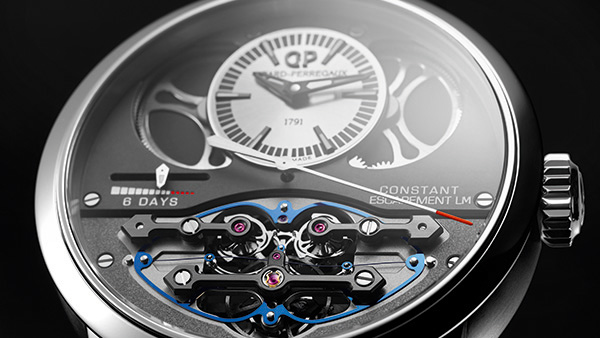
Girard-Perregaux: Precision Motors
By Victoria Gomelsky
For its 225th anniversary, Girard-Perregaux creates timepieces that honor its technical achievements and sophisticated style.
The most rarefied realm of the luxury watchmaking universe is home to a mere handful of firms. Girard-Perregaux is squarely among them. Founded in 1791 in La Chaux-de-Fonds, Switzerland, the watchmaker celebrates its 225th anniversary this year with a slew of models that capitalize on its well-established expertise in precision timekeeping.
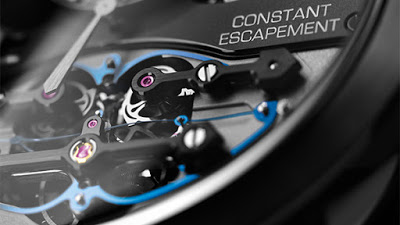
The silicon buckled-blade
Avant-garde Horology
Exhibit A: Girard-Perregaux’s pioneering Constant Escapement L.M. timepiece, which provides a solution to a timekeeping problem that bedevils most mechanical watches: the near-mythical attainment of constant force. You see, traditional escapements — the element of the movement most critical to a watch’s functionality — tend to lose power when transferring energy from the mainspring, or barrel, to the balance wheel, which governs timekeeping. This happens when the spring unwinds and gradually loses energy between windings, thereby transferring less and less power to the balance wheel, and wreaking havoc on the watch’s accuracy.
In 2008, Girard-Perregaux introduced a few prototypes that aimed to address this problem. But it wasn’t until 2013 that the Constant Escapement made its official debut. The result of a years-long research process to improve the science of chronometry, the L.M. model now boasts an unprecedented level of precision thanks to a brand new escapement design featuring a 14-micron silicon buckled-blade (that’s six times thinner than a human hair!) that accumulates energy before releasing it in a single impulse. Regardless of the amount of energy left in the spring, the watch keeps on ticking at a constant rate.
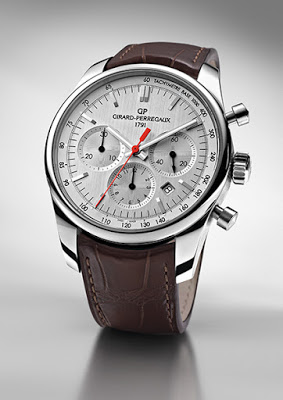
Stradale Chronograph
Enviable precision, however, is far from the only quality to recommend the timepiece. The 46mm case is another. It’s made from a titanium and carbon-composite material that’s both strong and lightweight; in fact four times lighter than titanium, and eight times lighter than steel. It has a manual movement that displays the time and the six-day power reserve. Its strikingly avant-garde design is the perfect package for the revolutionary mechanics contained within.
The Sporting Life
Girard-Perregaux’s Stradale Chronograph — part of its new “Competizione” line of chronographs — takes inspiration from the manufacture’s first sport chronographs, which emerged in the 1960s. They included a three-counter model, dubbed the “Ready-Go,” designed for rally drivers and motorcyclists. In the 1990s, Girard-Perregaux chose to honor these vintage models in a new chronograph collection paying homage to fast cars.
The Stradale borrows its aesthetic from these three decades’ worth of chronographs, as well as the brand’s iconic Club Italia model, a 1987 chronograph that’s considered something of a milestone piece because it was unveiled at a precarious time for the Swiss watch industry, when Japanese quartz technology was still dominant. The Stradale’s combination of polished and satin finishing, elongated lugs and vintage “mushroom-type” pushers lends the model its retro good looks.
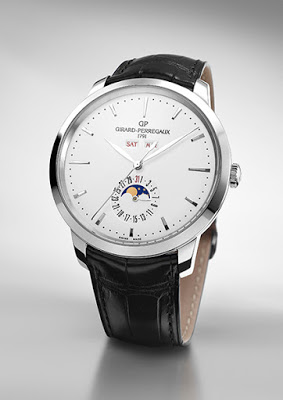
1966 Full Calendar
The Stradale Chronograph has a 42mm steel case that features a sapphire crystal caseback to provide a glimpse of its elegant automatic movement. The brand offers four versions: a black dial on leather strap or steel bracelet, as well as a silvered dial on strap or bracelet.
Calendar Year
For fans of classic haute horlogerie rendered in simple, straight-forward stainless steel, Girard-Perregaux recently unveiled the 1966 Full Calendar, the latest iteration of its signature 1966 model. The watch harks back to the manufacture’s 1960s heyday, when it was one of a handful of firms to have an in-house research and development department. The pièce de résistance of the 40mm timepiece is its full calendar with date, day, month and moon-phase indications; the complication’s usefulness is matched only by its elegance.
Powered by the GP03300 self-winding movement, the model is a flawless example of refined Swiss finishing. Its mainplate and bridges are drawn, beveled, circular-grained and decorated with côtes de Genève as is the steel oscillating weight. For luxury watch aficionados in search of a dress watch beloved by the cognoscenti, the 1966 Full Calendar is a worthy investment.
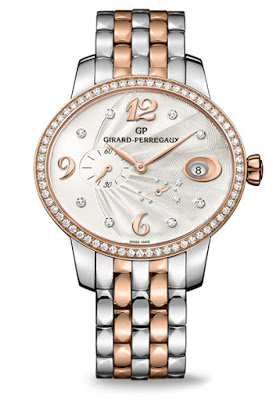
Cat’s Eye Power Reserve
Purrfection
Despite Girard-Perregaux’s well-documented expertise in creating technically advanced men’s watches, the company has long nurtured its female collectors. In 2004, the manufacture debuted the Cat’s Eye line, a collection of shapely ladies’ timepieces with a seductive oval silhouette. Over the course of the next decade, the collection grew to accommodate countless variations and complications, including the well-received “Bi-retro” model, whose two retrograde hands display the seconds and days of the week.
The newest version, the Cat’s Eye Power Reserve, comes on a chic bi-color bracelet composed of rose gold and stainless steel links. Its self-winding mechanical movement displays the time and date, as well as the 46-hour power reserve. Available with or without a diamond bezel, the distinctive oval case embodies the genteel elegance for which Girard-Perregaux is famous.
